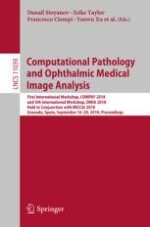2018 | Book
Computational Pathology and Ophthalmic Medical Image Analysis
First International Workshop, COMPAY 2018, and 5th International Workshop, OMIA 2018, Held in Conjunction with MICCAI 2018, Granada, Spain, September 16 - 20, 2018, Proceedings
Editors: Danail Stoyanov, Zeike Taylor, Francesco Ciompi, Dr. Yanwu Xu, Anne Martel, Lena Maier-Hein, Nasir Rajpoot, Dr. Jeroen van der Laak, Mitko Veta, Stephen McKenna, David Snead, Emanuele Trucco, Mona K. Garvin, Xin Jan Chen, Dr. Hrvoje Bogunovic
Publisher: Springer International Publishing
Book Series : Lecture Notes in Computer Science
